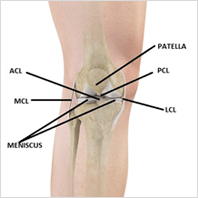Knee

The knee is made up of four bones. The femur or thighbone is the bone connecting the hip to the knee. The tibia or shinbone connects the knee to the ankle. The patella (kneecap) is the small bone in front of the knee and rides on the knee joint as the knee bends. The fibula is a shorter and thinner bone running parallel to the tibia on its outside. The joint acts like a hinge but with some rotation.
The knee is a synovial joint, which means it is lined by synovium. The synovium produces fluid lubricating and nourishing the inside of the joint. Articular cartilage is the smooth surfaces at the end of the femur and tibia. It is the damage to this surface which causes arthritis.
The knee ligaments include anterior cruciate ligament (ACL), posterior cruciate ligament (PCL), collateral ligaments – superficial medial collateral ligament (MCL), deep MCL, lateral collateral ligament (LCL).
Knee problems may arise if any of these structures get injured or diseased. Injuries and disorders of the knee include ligament injuries, meniscal injuries, patellar tendinitis, osteoarthritis, patellofemoral pain, iliotibial band syndrome and patellar dislocation.
Knee problems can be treated with conservative or surgical procedures.
Knee
Conditions
- Patellar Dislocation/Instability
- Patellar tendinitis
- Posterior cruciate ligament injuries
- Chondral (articular cartilage)defects
- Patellar instability
- Patellofemoral instability knee
- Patellofemoral dislocation
- Patella fracture
- Quadriceps tendon rupture
- Patella tendon rupture or tear
- Lateral meniscus syndrome
- Medial meniscus syndrome
- Tibial eminence fractures
- Osteonecrosis of the knee
- Knee angular deformities (Knock legs & bow legs)



